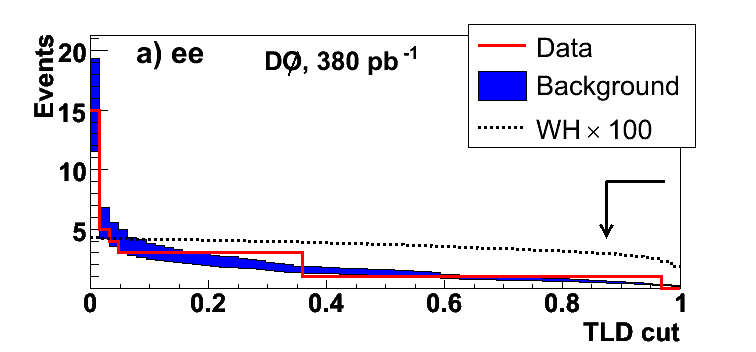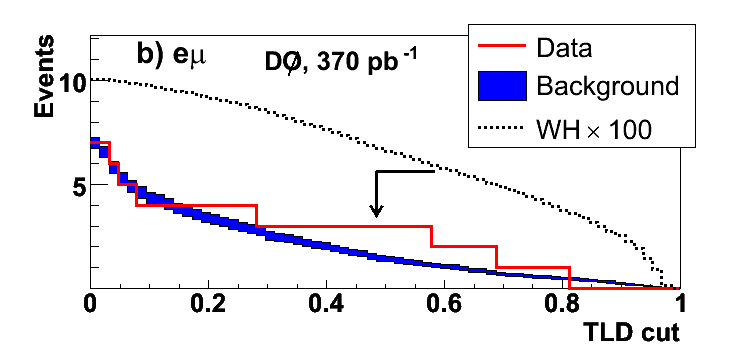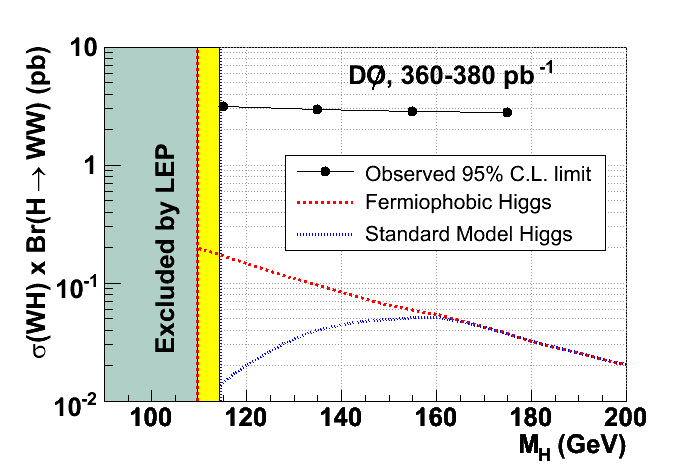Search for associated Higgs boson production WH->WWW*->l±nu l'±nu' + X in ppbar collisions at sqrt(s)=1.96TeV
The original paper: hep-ex/0607032
The most fundamental question in the modern particle physics
is origin of mass. The standard model
that describes the fundamental particles that make up the
matter around us and the forces that hold these particles
together, tells us that mass arises due to a so-called Higgs
mechanism, named after its inventor, Peter Higgs. This
mechanism implies existence of a new particle (Higgs boson)
which currently remains the only fundamental particle in the
standard model that has not yet been observed. Ironically, for
a particle that is a quantum of a field that gives mass to all
particles, the theory does not predict its mass. From the
experiment, we know that the Higgs boson cannot be too light
(like W or Z boson) -- otherwise it would be already
discovered. It is also improbable that the Higgs boson is very
heavy (like top quark), because this is unfavored (but not
ruled out) by measurements of other quantities that are
related to the Higgs mass.
At the Tevatron,
the world highest-energy particle accelerator the Higgs bosons
must be produced in plenty. But this does not mean that the
Higgs boson can be easily observed. As with many other
particles, the Higgs boson is unstable and quickly decays into
other particles, so the way to observe it is to look at the
products of its decay. The way the Higgs boson decays depends
on its mass. A "low mass" Higgs boson (less than
135 GeV1) predominantly
decays to a pair of b-quarks, while a "heavy" Higgs boson
(with mass greater than 135 GeV) mostly decays to a pair
of W (and with lower probability, Z) bosons.
Figure 1. The observed number of events (solid lines), the
predicted background (shaded bands), and the expected number
of signal events times 100 (dashed lines) for Higgs mass
155 GeV above the TLD cut in the (a) ee, (b) eµ,
and (c) µµ channels.

|

|

|
Most of the Higgs bosons at the Tevatron are produced directly
(i.e. without any accompanying particles). Unfortunately it is
very difficult to separate these events from (much more
frequent) cases when a pair of b-quarks or W-bosons is produced
in a process other than Higgs decay ("non-resonant
production"). More promising is an approach to search for events
due to Higgs bosons produced in association with a W (or Z)
boson. While the production rate for these events is several
times lower than for the direct production, the accompanying W
boson provides a "handle" that makes it convenient to separate
the signal events from the background (although for low mass
Higgs the non-resonant W+bb production is still non-reducible
background).
In the present analysis, we are searching for associated Higgs
boson production where the Higgs bosons decay to W pairs. In the
end, there are three W bosons in an event. This process is
unique in a sense that (considering the situation when two of W
bosons of the same charge decay to a lepton and neutrino), the
final state is characterized by two high momentum isolated
leptons of the same charge. Very few physics processes lead to
this signature, most prominent ones being the di-boson (WZ and
ZZ) production. The non-resonant WWW production is also
possible but has much lower rate than the Higgs signal. The
real challenge in this analysis appears to be instrumental
background, i.e. events that look like signal but are there due
to various technical reasons. An example is a
Z->e+e- process where one of electrons
emits a photon which undergoes a conversion (produces an
e+e- pair). In the end, there are two high
momentum electrons with the same charge that can mimic the
signal. Another source of background is "charge flips" (particle
charge misidentification) related to the fact that the charge
determination becomes less reliable as the muon (or electron)
momentum increases (the charge is measured as a sign of the
curvature of the particle trajectory moving in a magnetic field,
and for very energetic particles the trajectories become
indistinguishable from straight lines).
Figure 2. The observed upper limits for
the four mass points along with the theoretical
predictions for the standard model and
fermiophobic Higgs boson production.

|
A search for the Higgs boson in the
WH->WWW*->l±nu l'±nu'+X
mode has been performed at the D0 detector at the Tevatron using
data collected between August 2002 and August 2004. This is the
world first published analysis on the Higgs boson search in this
mode. We consider three final states:
e±e±,
e±µ±, and
µ±µ±. After
initial event selection (two high momenta isolated leptons) we
are left with 34 events, mostly due to instrumental
background. To further distinguish between the signal and
background, we use the technique known as topological
likelihood discriminant (TLD). The dependence on the number of
events remaining after a TLD cut vs minimal TLD value is shown
in Fig.1. Shown with arrows are optimal cut values that provide
the best expected production cross section upper limits.
The results (observed upper limits for four Higgs mass points
along with the theoretical predictions) are shown in
Fig.2. Unfortunately we still cannot observe (or exclude the
existence of) the Higgs boson. We need more data, and in
the end we will have to combine this search with results in
other search channels (and with results from our colleagues from
another Tevatron detector, CDF). This study is just the
beginning.
If you have questions regarding this analysis, please contact
Alexander Khanov.
1 GeV is a unit of energy
(and mass in units where speed of light equals 1) in high
energy physics. The proton has a mass of approximately
0.938 GeV.
Last modified: Mon Oct 23 14:31:03 CDT 2006



